Winter time is not considered the best period for construction work. But there are situations when the conservation of the construction site can lead to significant damage. In winter, it is most difficult to carry out bricklaying, however, even this task is quite feasible.
Brick laying in winter should be subject to certain rules, due to which construction work can be carried out in its entirety even at temperatures up to -50 ° C.
Problems of bricklaying in the winter
When laying brick in cold weather, it is most difficult to provide the building with the required strength. When the air temperature is below zero, the water contained in the fixing solution freezes, thereby terminating the necessary process of cement hydration. If the water does not have time to turn into ice, but at the same time it gets from the cold to the warm, this will lead to the surface of the bricks being covered with ice. After some time, the ice located both inside the masonry and on the surface of the bricks will melt, but the adhesion of the solution will decrease significantly. After complete thawing, the strength of the masonry will decrease by about a quarter from the required standards. In addition, when the water in the solution turns into ice and then thaws, free spaces form in the masonry, due to which the structure may collapse after some time.
How to prepare a mortar for bricklaying
Despite the existing disadvantages, brick laying in frosts can be no less durable than in the warm season. However, this requires a special solution.
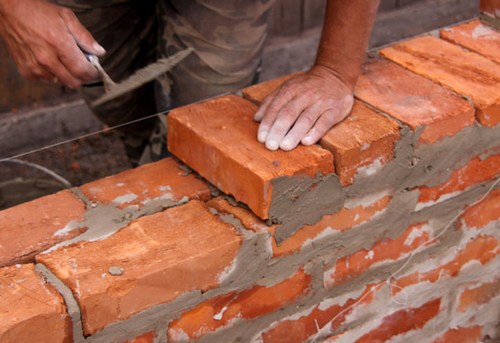
Antifreeze additives should be included in the mortar for masonry bricks, which will ensure a decrease in temperature. It is recommended to use a brand of at least 50, where the necessary additives are already included. The most important thing is to follow the process of solidification of the solution. To do this, small nests with plugs are made in the masonry, so that you can measure the temperature both inside and outside with a thermometer.
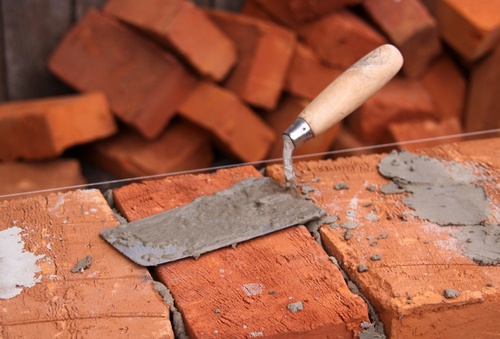
Bricklaying in winter conditions
The masonry optimal for winter time can be made by artificial heating or by freezing. In some cases, at very low temperatures, additional heaters must be installed above the masonry itself.
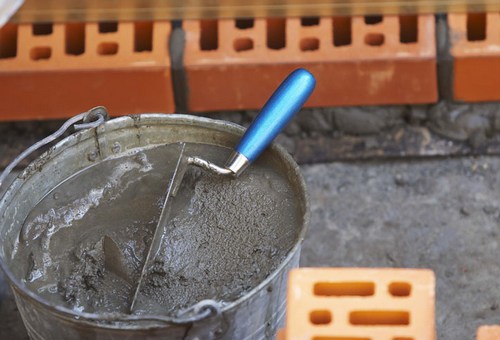
Winter mortar for bricklaying
Getting to work, you need to consider that all antifreeze additives are toxic to humans. You can work with them only in overalls, goggles and tight gloves.
For the same reason, any mixtures containing chemical additives are allowed to be used only for the construction of retaining walls and foundations. Bricklaying in winter conditions using chemical mixtures is strictly prohibited for the construction of residential premises.
Methods of laying brick in the winter
Laying in negative weather is most often carried out in the following ways:
- Electric heating
Since this method is quite time-consuming and energy-intensive, it is recommended to use it only for the construction of small sections of walls. During the masonry of the walls, electrodes are placed horizontally in the finished solution, through which electricity will later be passed. When heated, the electrodes will also heat the joints of the masonry, which, accordingly, will eliminate the formation of ice. However, for efficient electric heating, it is extremely important that the seams are completely filled.
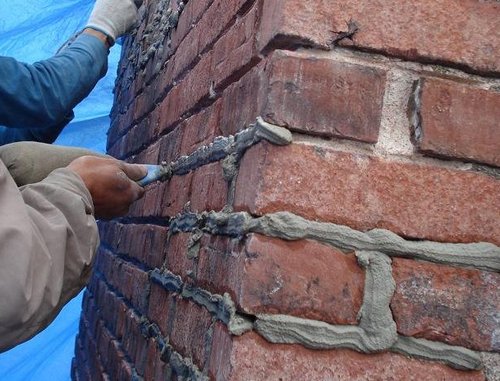
Brick laying in negative weather
- Erection of a greenhouse
This method is very effective, but rather laborious. Its essence lies in the fact that around the future wall or part of the wall, a frame of rails is installed. The frame is covered with plastic wrap or similar materials. In order to provide heat to the future construction and masonry mortar, any heat source must be installed inside the frame, for example, a stove, generator, electric heater, etc.
In order for the winter masonry of the brick to be erected in accordance with all the required standards, it is necessary to heat the heat for several days. Since it is practically impossible to erect a frame teak over an entire house or at least over one wall, this method is suitable exclusively for the construction of individual elements.
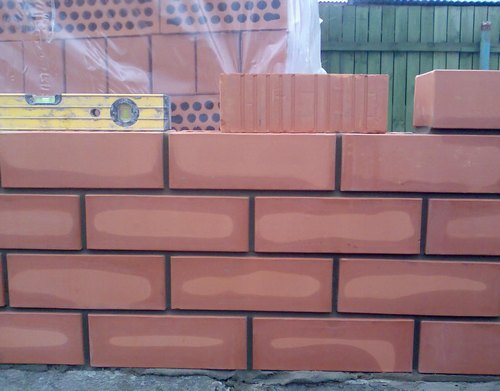
Cladding brick laying in winter
- Freezing method
Cladding brickwork in winter is most effective if the work is done according to the method of freezing. The essence of the freezing method is based on the fact that a special cement mortar for winter bricklaying can set again some time after thawing.
For masonry according to the method of freezing, you can use only a heated solution and a brick completely cleaned from freezing. If the ice on the bricks has already formed, it is more convenient to remove it with an injection burner. In addition, for this method it is recommended to use the highest grade of solution.
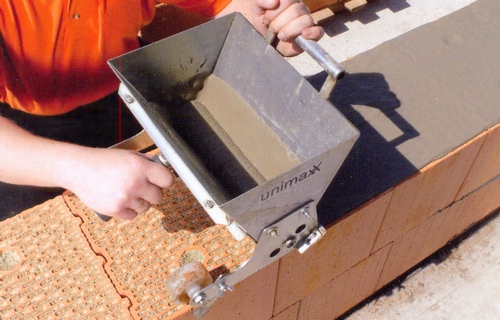
Is it possible to lay a brick in winter
The solution has the ability to cool quickly, because of which ice is formed in it. Therefore, it needs to be heated up for a maximum of half an hour. To avoid freezing, the solution must be diluted in small portions.
Also, the answer to the question - is it possible to lay a brick in the winter, depends on the quality of the work. During winter masonry, it is necessary to carefully monitor the fullness of the seams, especially vertical ones.
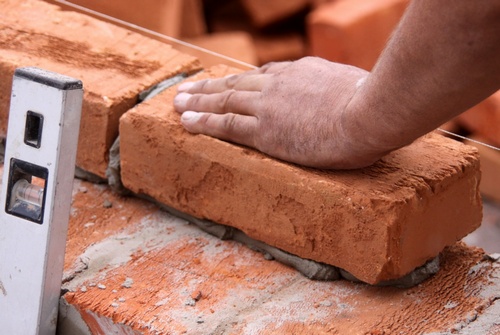
Final work
After the erection of a brick wall to a level not higher than one floor, it is necessary to install prefabricated ceilings. If the masonry is carried out by freezing, the height of the erected structure in winter should not exceed 15m.
In addition, it is extremely important to monitor the masonry with the advent of the thaw. In order to provide additional stability and strength of the brickwork in the spring, it is necessary that the distance between it and the transverse walls does not exceed 20 m. In addition to all of the above, the walls on the south side must be hung with a glassine or moistened.
At what temperature they lay a brick, every master knows his job. Most often, construction work is carried out in warm, dry weather. This is due to the properties of the solution and the specifics of the work itself. Hardening the solution and digging out trenches under the foundation is difficult in the cold period. It is necessary to use cement mixtures at sub-zero temperatures quickly, as the water contained in them may freeze.
The construction of a brick house should be carried out in a certain temperature regime.
Due to the difficulties of erecting masonry in the cold, they rarely decide on construction. However, there are situations that bricklaying in winter is simply necessary. In order to cope with the task with brilliance, it is necessary to know certain rules for bricklaying and the features of mortar solidification.
Optimal temperature for work
Temperature directly affects the strength of the solution.To ensure the best masonry quality, all work should be carried out in warm weather. In this case, the air temperature can vary from 10 ° C to 25 ° C of heat, and humidity - up to 75%. Such conditions allow you to create a solid and high-quality design. The decrease in temperature is directly related to the deterioration of the solidification of the solution. A temperature below 0 ° C will freeze the water, which is a component of the composition. At the same time, adhesion with the brick and the quality of the masonry will deteriorate.
If setting occurred before the temperature drops and the solution holds the masonry, it may not harden due to freezing of water. At sub-zero temperatures, it loses the following qualities:
- elasticity;
- density of filling the joints between the bricks;
- strength - this characteristic does not return even with the establishment of a positive temperature and solidification of the solution.
The pour time of the cement mixture at low temperatures increases by 4 times. If negative, the solution simply freezes. As soon as the air temperature starts to rise, the composition defrosts, but then it loses some of its basic properties. Brickwork made in winter conditions will differ in strength from summer. Assuming to lay a brick in the winter, it is worth considering the following construction features:
- water in the solution is converted to ice, which leads to an increase in volume by about 10%, with thawing it decreases;
- it is difficult to maintain the strength characteristics of the masonry;
- instability of temperatures in winter can lead to the formation of cracks throughout the structure due to voids appearing in the solution;
- frost may form on the brick.
Low temperature operation
The main difficulties in construction work in winter conditions are associated with the cement composition, since it is it that is susceptible to temperature influences. In this regard, it is necessary to take into account some features of such construction:
- Anti-frost impurities should be added to the composition, increasing the temperature of the entire solution and preventing solidification. If available, masonry can be done up to -50 ° C.
- The mobility of the composition will be in the range of 10-13 cm along the cone.
- The plastic solution should remain so, then it will fit well.
- After laying, the temperature of the mixture should be checked periodically. For this purpose, you can leave small recesses for the thermometer in the masonry.
Bricklaying in winter is carried out using the same technologies as in the warm season: the brick is laid on a cement mixture. To winter masonry was better, apply the following methods:
- installation of a teplyak;
- the addition of antifrosty impurities;
- electric heating;
- thermos method;
- freezing.
To install a teplyak, you need rails and ordinary polyethylene in a roll. First, a rack frame is erected around the entire construction, and then polyethylene is mounted on it, creating airspace. The heating of the entire area is made by special devices. Under such conditions, an acceptable temperature is maintained at which the solution sets, and then solidifies. The heat inside the greenhouse must be maintained for several days. In this way, it is difficult to heat a large area.
Adding antifrosty impurities helps to reduce the temperature indicators of freezing water, therefore, it allows the solution to gain the necessary strength even in frost. Most often, mixtures of sodium chloride and potassium are added for this purpose. Mixtures of sodium nitrate and potassium carbonate can be used without subsequent heating, however, the temperature of the solution should not be lower than + 5 ° C.
Electric heating is possible for part of the masonry. For this, electrodes powered from the mains are horizontally placed in the solution. When heated, they give heat to the mortar and bricks. In this case, the solution hardens well, but only with high-quality filling of all vertical joints.
In the absence of electrodes, a wire with a diameter of 0.3-6 mm can be used.
The thermos method is the simplest method that provides solution hardening in winter conditions. In this case, the heat of the material itself is used, which is stacked in parts. Each installed part is covered with a thermal insulation material that does not allow heat to be lost.
Freezing method
The brick is placed on a solution heated to a high temperature, which cools down after the construction is completed, and then freezes. A similar brick laying method ensures the strength of the wall until it finally freezes. In the spring, the put mixture thaws and hardens. However, this process is accompanied by a fairly strong shrinkage of the entire structure, which can lead to the destruction of buildings more than 15 m high.
At what temperature can I put a brick? When using the freezing method, it is important to adhere to several rules:
- Observe the same temperature of the mortar in all areas, otherwise the brickwork will be deformed after thawing and the finished bed can not be fixed.
- This method is effective when working at temperatures not lower than -30 ° C.
- If the frozen solution is diluted with hot water, this will contribute to the formation of pores in the seams in which there used to be ice.
Using the above methods of preparing the solution will significantly improve the reliability and strength of the masonry. Before using any of them, it is necessary to prepare in advance all the required materials, determine the estimated costs.
Very often, workers have to deal with the situation when construction is completed in the conditions of crackling frosts, which is especially important for the northern regions of the country. Such weather pleases many, but not the customer and builders, since the construction of the building must be completed on time, with due quality of performance in any conditions. How to make high-quality brick laying, if outside the window minus temperature and prolonged warming are not expected?
The opinion of qualified specialists gives good hope with solid statements about the possibility of continuing or completing stone work in such a situation. The implementation of bricklaying is possible in any weather, subject to the observance of special technologies and the consideration of certain nuances. Let us consider in more detail the features of brickwork in the cold.
Difficulties of bricklaying in frosty weather
The difficulty of winter masonry, which determines all the problems, lies in the freezing of the cement mass, or rather, the water contained in it. This violates the normal hydration processes and the strength of the solution loses about a quarter of the required norm. This circumstance leads to inferior adhesion of building elements, which directly affects the overall stability of the building. It is reduced, and this can lead to unpleasant, sad consequences.
In addition, temperature and humidity will cause:
- destruction of the structure of bricks from the process of freezing moisture in them;
- the formation of a thin ice crust on the surfaces of the connected elements;
- the formation of numerous voids in the frozen solution after normalization of temperature.
Finding, and even more so living in such a house becomes dangerous.
Attention! If you correctly observe some of the "winter" principles of laying luggage, then there will be no problems with high-quality construction and the construction will be reliable!
Features of mortar for bricklaying in winter
The cement mortar used for the “winter” brick laying has slight differences from the “summer” mixture. The proportions are kept the same, but special additives are added. These additives prevent freezing of water, providing the necessary level of resistance to temperature drops. It is necessary to choose such modifiers thoroughly, since each of them provides tolerance to a small range of negative temperature.
Watch the video how to knead masonry mortar in frost
Recommendation! During masonry, it is necessary to control the state of the solution, namely, the course of its solidification. For this purpose, several special plugs are placed in concrete, in which the temperature value is measured with a thermometer (4 times a day)!
Read also: Walkthroughs on building walls and corners
However, the use of additives is unacceptable in the construction of residential buildings, as they contain toxic compounds that are very harmful to humans. Therefore, anti-freezing additives are added to the cement mortar of the foundations or the masonry mixture for non-residential and auxiliary buildings. At the same time, every worker should use protective equipment, devices and protective clothing.
Some builders, in order to save money, introduce liquid soap into the solution. This component reduces the total amount of water in the solution. After thawing, the soap composition does not affect the hydration of the cement, but the number of voids, stratifications and cracking of the brick is significantly reduced.
Brick masonry techniques at low temperature
In addition to the use of antifreeze additives, there are a number of effective ways to build brick buildings in the cold. We will get acquainted with the most used and available technologies.
1. Electric heating of the solution - provides for the arrangement in the created masonry of a system of metal electrodes that will heat the hardening mortar and bricks. Between them, a controlled electrical closure will be created with the release of a sufficient amount of thermal energy.
Construction technology consists in equidistant placement (checkerboard pattern) of metal rods with a pitch of 21.0-23.0 cm in every second horizontal layer of the solution. Then, the protruding ends of the electrodes are connected into an isolated system - one layer - one electric pole. Thus, a uniform alternation of electrical wiring is obtained over the entire area of \u200b\u200bthe wall, the thickness of which will determine the magnitude of the supplied current. For example, a connected voltage of 220 volts will warm up a wall 1.5 meters thick to + 3o degrees. Therefore, for normal heating of a 50.0 cm wall, approximately 74 volts must be supplied. However, an accurate calculation should be carried out by specialists, taking into account all the features and characteristics of the materials.
 Contact will occur through the mortar and wet areas of the bricks. These places will begin to constantly heat up, and heat will spread evenly over the area of \u200b\u200bthe entire masonry, forming a comfortable oasis for normal hydration (hardening) of the fixing composition.
Contact will occur through the mortar and wet areas of the bricks. These places will begin to constantly heat up, and heat will spread evenly over the area of \u200b\u200bthe entire masonry, forming a comfortable oasis for normal hydration (hardening) of the fixing composition.
Explanation! Electric heating is necessary only at the time of reaching 22% of the brand strength of the cement mortar. As a rule, it is 6-7 days!
Read also: Rules for the construction of brick walls and corners
The method has some disadvantages:
- you need a competent, accurate preliminary calculation of all parameters;
- energy costs, creating considerable additional financial losses;
- continuous monitoring of the electrode system and the level of heating;
- the most protected from electric shock, specially trained personnel.
2. Laying in thermoses - The technology is based on the maximum long-term retention of its own heat released during chemical reactions in cement mortar, thermal insulation coating. It is enough to lead masonry in conditions of minimal cold (up to -5 degrees).
To ensure a significant temperature reserve, immediately before placement, each brick is heated by a blowtorch, a special gas burner, or similar devices. The type of material is not critical for the job. You can stack double silicate, clinker cladding, “red”, ordinary solid and other types of bricks.
 During operation, every three (maybe four) layers, the masonry is closed with a heat-insulating material. Wall sections protected by this method will self-heat for a long time.
During operation, every three (maybe four) layers, the masonry is closed with a heat-insulating material. Wall sections protected by this method will self-heat for a long time.
“Thermos” technology is simple to implement, does not require special knowledge, the use of protective equipment, additional costs and extensive practical experience.
When building a house, of course, I want the process to go faster, without stopping even in the winter. In order to justify work at sub-zero temperatures and understand how masonry reacts to frost, we consider the physical and technical nuances of masonry and ways to "get around" the climate.
Nuances of a winter building
In the construction of brick walls in the classic version, it is supposed to use mortar. In order not to discover America, you can use the usual cement mortar:
- Sand (quarry; river - an expensive option).
- Cement (grade 400 - for any work).
- Water.
Among the three components of cement, only water impedes winter construction. This is because the bricks in the masonry are not bound by mortar at a negative temperature.
When the temperature drops below zero, the water becomes ice. As a result, the desired physical reaction does not occur between the ingredients of the solution.
Theoretically, it is possible to put a solution, of course, but at the same time it will freeze to a natural state of hardness, and therefore, there will be no masonry strength or binding of the solution.
Thus, with a decrease in temperature, it is impossible to lay bricks according to standard work schemes. However, there are other options for the composition of solutions and winter work.
Solution properties
In addition to various methods, chemical additives are also needed. Basically, these are special anti-cold remedies.
During construction, special nests are created at the seams, plugged with plugs, and temperature measurements are constantly carried out. It must be taken into account that the brick, for example, is full-bodied, it conducts the cold rather slowly, so there is time for the mortar to set.
While there is an exothermic reaction that adds heat, the solution is “pressed” with brick from above and below.
As a result, we get a table in which the air temperature corresponds to the temperature of the solution.
- 5 degrees - minus 10 degrees;
- 10 degrees - minus 10-20 degrees;
- 15 degrees - minus 20 degrees.
Freezing method
In this case, even despite the negative temperature, the brickwork is carried out in the open air, while the mortar has a rather high temperature.
This method is based on the fact that in the joints the solution is frozen and gradually hardens in the spring (partially - directly during masonry). Thus, thermal energy is constantly released during the chemical interaction of cement and water.
Important! This method allows you to build a wall with a length of not more than 15 m. With a technical safety standard, strength can be calculated in accordance with the spring period of hardening of the cement.
Chemical additives
Another way is chemical additives. They perform several functions:
- The freezing rate of water decreases several times at sub-zero temperatures.
- The solution sets and hardens faster, but does not lose its qualities.
The main additives that can be used with instructions:
- Potash (reduces the hardening time of the solution at indicators below minus 25 degrees). When the solution sets quickly, it partially loses its properties, so you can add mash from yeast - 1%.
- Sodium nitrate (not less than 15 degrees).
Important! Most modern supplements are poisonous, and therefore, you must follow safety rules and work exclusively in protective clothing.
Thermos Method
Using this method, it is possible to carry out work at minus temperature indicators. If with the standard method it is possible to work at temperatures up to minus 5 degrees, then with its further decrease either chemical additives or other working methods are required.
The thermos method consists in the fact that the cement mortar emits during masonry heat sufficient to maintain a good hardening process. In addition, two conditions must be taken into account:
- Before installing the brick is heated. To do this, you need an ordinary blowtorch. Full brick and double silicate M 150 are subject to heating.
- Masonry after a few square meters or rows is covered by a layer of heat insulator.
This method is quite simple, so if it is necessary to continue the construction when cold weather sets in, then it will not be difficult for a beginner to apply it. The main thing is that you can do everything yourself, and conveniently and quickly.
Electric heating
The essence of the electric heating method is to attach the sewn-in electrodes from the side of the outer wall. An electric current is passed through the cement mortar, thereby warming it.
When the building mixture warms up, the brick receives heat, as a result, a warm island forms on the wall. Thus, without changing the physical properties of the solution, the masonry gradually hardens.
Advice! When it is necessary to use electric current during construction, it is important not only to provide insulation, but also the presence of a heated base.
Additional secrets
The question of what temperature is optimal for bricklaying becomes relevant in cases where it is impossible to conduct electricity or when there are no chemical additives. But at the same time, construction often stops in winter.
This is especially important in the private sector, since there you need to hold engineering networks and communications. The optimum temperature for work is up to minus 5-7 degrees, with a further decrease in it, the above methods should be used.
However, the question of temperature for masonry will cease to be acute when there is ordinary salt. If you use it, then the work continues at any negative temperature. In addition, this effective method is cost effective because it is inexpensive.
On the other hand, in the future, excess salt may protrude from the wall. In this case, the facade will need to be repainted repeatedly.
Conclusion
All these methods help in the construction year-round. Supporting information can be found in the posted video for this article (also on how to prepare a solution during construction in winter).
It can be laid out qualitatively only at positive air temperatures and sufficient humidity. With decreasing ambient temperature, the process of hardening of the solution slows down, and when it reaches 0 ° C, it completely stops. When freezing, the solution turns into a composition with separately ice-bound components. The plasticity of the solution is lost and the masonry joints are not compacted.
In order for bricklaying work to be carried out efficiently in winter, the temperature of the non-solidified mortar should be above 0 ° C, and the bricks should not be moist and covered with snow.
The solution should harden before acquiring brand strength within 28 days. With its early freezing and thawing, subsequently, the strength decreases by 50% of the standard. After thawing under the influence of the severity of the masonry, uneven settlement and loss of stability of the structure occur.
To prevent the effects of low temperatures on the solution in the winter, special measures are applied to preserve the properties of the solution and the strength of the masonry. These include:
- the addition of antifreeze components;
- use of electric heating;
- application of the freezing method.
Principles of bricklaying by freezing mortar
In this method, the solution is heated before production and partially hardens during laying, having a positive temperature before freezing. After thawing with increasing ambient temperature, the mixture sets completely. The technology of such winter masonry should be provided for in the construction project initially.
Without preliminary calculations of the strength of structures constructed in this way, masonry is not performed.

To prepare the solution in the winter, it is necessary to use warm water.
The detailed design of a building erected in winter conditions using the freezing method should contain additional requirements for masonry technology:
- compliance with the maximum height of structures erected during the initial hardening of the mixture and in conditions of its thawing;
- the need to install temporary fasteners of brick structures during thawing;
- the use of certain brands of solutions and compliance with the features of the masonry process.
The masonry mortar used under winter bricklaying conditions must have a brand of at least 10. A certain grade is assigned in accordance with the temperature at which work is carried out:
- at an average daily temperature of not lower than -3 ° С, the brand of the solution corresponds to the brand used for such structures in warm conditions;
- if this indicator drops to -20 ° C, the brand value increases by one position;
- in severe frosts below -20 ° C, the solution is used with a brand increased by two values.
In the winter period of construction, complex (cement-clay and cement-lime) masonry mortars are used. Organic plasticizers (microfoaming agents) are added to them. Portland cement, pozzolanic and slag Portland cement are used as binders. Sand is added completely dried.
The temperature of the mortar to be laid should be 5, 10 and 15 ° C at an external temperature of -10, to -29 and below -20 ° C, respectively. These values \u200b\u200bare maintained at wind speeds of up to 6 m / s. With a stronger wind, the solution should be warmer by another 5 ° C. Water should not be hotter than 80 ° C, and sand temperature should not exceed 60 ° C. The solution should be delivered to the site in insulated containers. Large volumes of the mixture are transported to the site in auto-transporters with tanks heated by the exhaust gases of the engine.
Brick masonry technology using the freezing method

During the construction of the walls, winter masonry is carried out at approximately the same level throughout the building. The boundary of the site should be a sedimentary seam. On the finished wall immediately laid slabs or beams. In walls erected in winter conditions, reinforced concrete lintels are used. When flying up to 1.5 m, it is possible to use ordinary lintels with the use of suspended formwork (on a circle). If the formwork rests on racks, they are placed on wedges. When thawing the solution, the wedges are loosened to evenly masonry. Racks are located in the middle of the wall, preventing their displacement. The formwork from the jumpers is removed after 15 days.
During the laying of bricks, the joints should be filled properly before the mortar freezes. The solution is laid in small sections on 2-4 spoon bricks and 4-6 in rubble. In winter, masonry should be done as quickly as possible, especially in height. It is necessary in a short time to compact the solution in the row with the weight of the upper row. For this, the masonry is made in small areas. The mixture freezes after about 2 hours.
In winter, during the laying process, it is necessary to strictly observe the required thickness of horizontal and vertical joints. Their final compression occurs only in the thaw after complete thawing. Excessive thickness of the joints can lead to severe upsetting and, possibly, to structural failure when the temperature rises.
Before interruption in winter conditions, the vertical masonry joints must be carefully filled with mortar. At the time of stopping the work, the unfinished masonry is covered with a layer of brick (dry) or with a layer of roofing. Before resuming the process, the work surface is cleaned of ice, snow and frozen solution. The verticality of the wall is carefully monitored during operation, since its deviation can lead to disastrous consequences under thaw conditions.
Additional activities during masonry in winter conditions
- At the junction of the constructed walls and existing structures, as well as over door and window openings, sedimentary seams are made.
- At the joints of the external and internal walls, metal bundles of steel bars or strips are mounted. On each of the walls a bundle is installed for a length of up to 1.5 m.
- In lightweight masonry, in the corners of the docking, screeds are arranged in the inner and outer versts in pairs.
- Walls erected by freezing the mortar are strengthened using struts installed in the transverse direction.

When organizing bricklaying in the winter, the following conditions must be met:
- All structures of one belt are masonry using a solution having the same composition, temperature and consistency.
- Tanks for mortar used in the conduct of work must have lids and external insulation. The mixture should be reloaded as rarely as possible from one container to another.
- Thawed is prohibited to use. It must be recycled and then used again.
- Do not dilute the solution with hot water, as when hardened, a large number of pores with ice will appear in it, it will become loose. Upon final hardening, the material will not reach the required strength.
- Portions of bricks delivered to the masons ’workplace in winter should provide a continuous masonry process for 2 hours. A warm solution should be produced within 20-25 minutes.
- Injection burners should be used to remove ice and warm the masonry bed. For used special electroshipping.
Masonry heating in winter conditions
Building structures can be heated by gas units, oil and gas heaters and electric heaters. The temperature of the heated masonry at the level of 0.5 m from the floor should not be lower than + 10 ° С. To ensure this temperature, rod electrodes are used. They are made of steel rod with a diameter of 4-6 mm. The electrodes are introduced into the solution at a distance of 15 to 30 cm from each other, a voltage of 40-60 V is applied to them. The masonry is heated to a temperature of 40-60 ° C. Heating accelerates the crystallization of the solution by 20% in 12-18 hours. Due to this, the brick adheres to the solution. The method of electric heating of structures has not gained wide application in construction in the winter.
In some cases, a building erected by freezing is isolated from the outside air and connected to the heating system or installed inside for heating devices. When the internal temperature rises to 30-50 ° C after 3-5 days, the masonry thaws, then the solution hardens. The walls are dried using enhanced ventilation. After drying, they begin finishing work. After artificial heating, the strength of the solution should reach 20% of the brand.
Strength control of a brick building laid out in winter

To prevent the mortar for bricklaying from cooling too quickly, you can use a thermal insulation coating or a radiating heater.
Under thaw conditions, the masonry begins to thaw. During this period, its settlement occurs, the strength and stability of the structure decreases. Workers should monitor the direction, degree of uniformity and amount of draft. It is necessary to regularly check the condition of the masonry sections subjected to the greatest stress. Abandoned shabra, nests and other holes should be laid. Excessive loads must be removed from the floors (for example, construction debris or remaining building material).
Masonry sediment control is carried out throughout the entire thawing period. If areas with uneven settlement and cracks are found, measures must be taken to reduce the load. For this, discharge racks are temporarily installed under the edges of the supporting elements (floors, jumpers).
If wall deviations from the vertical are detected, as well as cracks in the areas where the longitudinal walls adjoin the transverse walls, additional extensions or braces are installed. With significant displacements, tension ropes are used to bring the structures to the design position. These measures should be carried out before the hardening of the solution in the joints (usually no later than a week after the onset of the thaw).
The use of antifreeze additives (PMD)

Antifreeze additives are used to lower the freezing point in the solution.
Brickwork in winter conditions can be carried out using a grade 50 mortar with the addition of special chemical compounds - antifrosty additives. They have the ability to accelerate the hardening of the solution at low (up to -15 ° C) temperatures. When using them, an accelerated process occurs with the involvement of the maximum proportion of water that the solution contains. In this case, the mixture retains mobility in the cold.
It should be noted that the use of antifreeze components does not provide one hundred percent strength of the masonry. In conditions of negative temperatures, they make it possible to erect a structure with 30-40% percent strength from the designed one. Then the solution freezes and gains the main strength only after thawing. Therefore, structures constructed in this way in winter conditions must bear a load not exceeding a specially calculated one.
During construction in winter conditions, various anti-frost additives (PMD) are used. In Russia, the following chemical components that prevent freezing for masonry are more often used:
- technical sodium formate;
- technical calcium formate;
- technical sodium nitrite;
- potash (potassium carbonate);
- calcium chloride.
A solution with chemical additives should not be used for rooms with high humidity during operation (baths, bathrooms, etc.). These inclusions are hygroscopic and contribute to the formation of efflorescence. A solution with PMD must be developed before setting. During the laying of bricks, it should have a temperature of + 5 ° C. When applying PMD, it is imperative that the instructions stipulate the type, proportions of additives and the rules for the operation of the premises constructed using such a solution be followed. For residential buildings, additives based on calcium chloride or sodium are not used, since they cause an increase in room humidity.
The disadvantage of the method of freezing when laying brick in winter conditions is the risk of deformation of structures during thawing of the mortar. But with strict observance of the technology of work and the correct geometry of the building, you can erect structures of the necessary strength.
